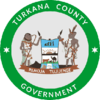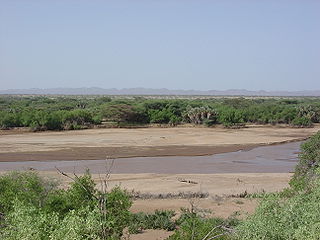
The Kerio River is a river in Turkana County, Kenya. It flows northward into Lake Turkana. It is one of the longest rivers in Kenya, originating near the equator.

The Turkana are a Nilotic people native to the Turkana County in northwest Kenya, a semi-arid climate region bordering Lake Turkana in the east, Pokot, Rendille and Samburu people to the south, Uganda to the west, to the South Sudan and Ethiopia to the north.

Isiolo is a town in Isiolo County, of which it is the capital. It is located in the upper eastern region of Kenya and is geographically considered the center of the country Kenya. It lies 285 kilometers north of the capital Nairobi. The town grew around the local military camps. Much of the population consists of Somali, Borana and Ameru community. The town has an estimated population of 78,250, most of them living around the outskirts of the town. Like most African cities, there has been a steady increase in the urban population in recent years, especially moving from as far as Moyale, Marsabit and Mandera. Isiolo town is also becoming a centre of interest because of its newly acquired status as a resort city cashing in on the popular Samburu and Shaba Game reserves, which have become preferred destinations after the famed Maasai Mara. Isiolo lies along the long A2 Road, leading towards Marsabit and Moyale much further north.

Lodwar is the largest town in north-western Kenya, located west of Lake Turkana on the A1 road. Its main industries are basket weaving and tourism. The Loima Hills lie to its west. Lodwar is the capital of Turkana County. The town has a population of 82,970 in 2019.
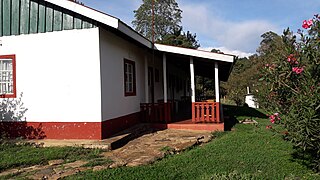
Kapenguria is a town in Kenya. It is the capital and largest urban center of West Pokot County. The town lies north east of Kitale on the A1 road along Kitale-Lodwar road in north Western Kenya. Kapenguria forms a municipality with a population of 40,751 as per the 2019 Kenya Population and Housing Census.

The Ilemi Triangle, sometimes called only Ilemi, is a disputed area in East Africa. Arbitrarily defined, it measures about 11,000 square kilometres (4,200 sq mi). The term "Ilemi" may more accurately be transcribed as "Elemi" in the Didinga language, signifying acceptance. This suggest that, in Didinga history, the region became favorable when they arrived, evidenced by the thriving health of the cattle that accepted the local vegetation, indicating a symbiotic relationship between the cattle's well-being and the area. The territory is claimed by South Sudan and Kenya. The territory also borders Ethiopia and, despite use and trespass into the triangle by border tribes from within Ethiopia, the Ethiopian government has not made any official claim on the area, instead agreeing that the land was Sudanese territory in the 1902, 1907, and 1972 treaties.

Baringo County is one of the 47 counties in Kenya. It is located in the former Rift Valley Province. Its headquarters and largest town is Kabarnet. The county is home to Lake Baringo, Lake Bogoria and Lake Kamnarok.

The constituencies of Kenya are used to elect members of the National Assembly, the lower chamber of the Kenyan Parliament. In accordance with Article 89 of the 2010 Constitution of Kenya, there are 290 constituencies, based on a formula where these constituencies were to be delineated based on population numbers. Each constituency returns one Member of Parliament. The constituencies are further divided to electoral wards.
Kacheliba Constituency is an electoral constituency in Kenya. It is one of the four constituencies of West Pokot County. The constituency has six wards, which are represented by Members of County Assembly at the West Pokot County Assembly in Kapenguria. The constituency was established before the 1988 elections in order to cater for the interests of the Kara-Pokot community following years of under representation. The constituency was created by the Electoral Commission of Kenya through a publication in the Kenya Gazette.

Sub-counties, also known as Districts, are the decentralised units through which government of Kenya provides functions and services. At national level, sub-counties take a more administrative function like security, statistical purposes, provision of government services, etc. Even though the sub-counties are divisions of counties, powers to create new national sub-counties lies with the national government. As of 2023, there are 314 sub-counties, compared to 290 constituencies. A deputy county commissioner is appointed by the state to lead each sub-county. The sub-counties are further divided into divisions, locations and sub-locations.
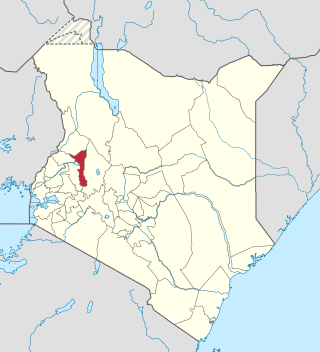
Elgeyo-Marakwet County is one of Kenya's 47 counties, which is located in the former Rift Valley Province with its capital and largest town as Iten. It borders the counties of West Pokot to the north, Baringo County to the east, southeast and south, Uasin Gishu to the southwest and west, and Trans Nzoia to the northwest.
West Pokot District, formerly known as West Suk or Kacheliba District, was an administrative district in the Rift Valley Province of Kenya. Its capital town was Kapenguria.
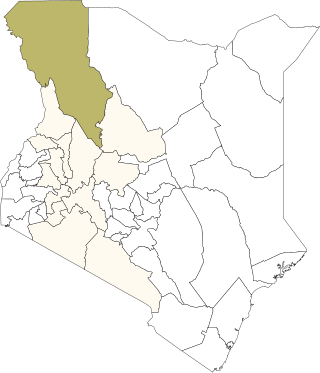
The Turkana District was an administrative district in the Rift Valley Province of Kenya. Turkana was the northwesternmost district in Kenya. It is bordered by the countries of Uganda to the west; South Sudan and Ethiopia, including the disputed Ilemi Triangle, to the north and northeast; and Lake Turkana to the east. To the south and east, neighbouring districts in Kenya are West Pokot, Baringo and Samburu districts, while Marsabit District is located on the opposite shore of Lake Turkana.
Despite its high potential for wind energy generation, wind power in Kenya currently contributes only about 16 percent of the country's total electrical power. However, its share in energy production is increasing. Kenya Vision 2030 aims to generate 2,036 MW of wind power by 2030. To accomplish this goal, Kenya is developing numerous wind power generation centers and continues to rely on the nation's three major wind farms: the Lake Turkana Wind Power Station, the Kipeto Wind Power Station, and the Ngong Hills Wind Farm. While these wind power stations are beneficial to help offset fossil fuel usage and increase overall energy supply reliability in Kenya, project developments have also negatively impacted some indigenous communities and the parts of the environment surrounding the wind farms.

Aiyangiyang is a basin in southern Turkana, Kenya, southeast of Lodwar. It is known by nomadic pastoralists for its seasonal water availability, and is an important archaeological and paleontological site with artifacts and remains from the African Middle and Late Stone Ages.
Lokomarinyang is the name of a village and a rolling hill west of the village. The village and the Ilemi Triangle in which it is located are disputed territories between South Sudan and Kenya. It is located off the E373 road, and is roughly circular-shaped and mainly composed of small huts and other minor residential and commercial structures.

The Sengwer people are an indigenous community who primarily live in the Embobut forest in the western highlands of Kenya and in scattered pockets across Trans Nzoia, West Pokot and Elgeyo-Marakwet counties. The Sengwer are sometimes portrayed as a component of the Marakwet people but are a distinct ethnic grouping with a distinct language.
Friends of Lake Turkana (FoLT) is a nonprofit organization in Kenya that was founded in 2007 by Kenyan environmentalist Ikal Angelei. The organization has worked to stop the construction of the Ethiopian Gilgel Gibe III Dam on the Omo River, Lake Turkana's primary source of water. Due to FoLT and other partner's advocacy work on saving Lake Turkana, the Lake was added to the list of world Heritage sites in Danger by UNESSCO in June 2018.
The Wajir Museum is a museum located in northeastern Kenya. The museum is in charge of showing the different cultures that inhabit Wajir. The museum is managed by the state-owned National Museums of Kenya Corporation. This is the first museum in Wajir County.

The Ethiopia–Kenya border was first identified by the United Kingdom in 1907 and refined in 1947 in the aftermath of the East African Campaign of World War II. When Kenya became independent, it was finally approved in 1970. The border stretches 861 kilometers bounded by Marsabit, Turkana, Wajir and Mandera Counties on the side of Kenya, and Borena and Dhawa Zones in the Ethiopian side. The border features enormous biodiversity and wildlife, most notably, several communities such as Mursi, Nyangatom, Daasanach and Turkana, which are agro-pastoralist in response to harsh climate and erratic weather patterns.


